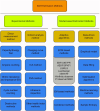Lithium-ion battery second life: pathways, challenges and outlook
- PMID: 38650673
- PMCID: PMC11033388
- DOI: 10.3389/fchem.2024.1358417
Lithium-ion battery second life: pathways, challenges and outlook
Erratum in
-
Corrigendum: Lithium-ion battery second life: pathways, challenges and outlook.Front Chem. 2024 Apr 24;12:1414996. doi: 10.3389/fchem.2024.1414996. eCollection 2024. Front Chem. 2024. PMID: 38721009 Free PMC article.
Abstract
Net zero targets have resulted in a drive to decarbonise the transport sector worldwide through electrification. This has, in turn, led to an exponentially growing battery market and, conversely, increasing attention on how we can reduce the environmental impact of batteries and promote a more efficient circular economy to achieve real net zero. As these batteries reach the end of their first life, challenges arise as to how to collect and process them, in order to maximise their economical use before finally being recycled. Despite the growing body of work around this topic, the decision-making process on which pathways batteries could take is not yet well understood, and clear policies and standards to support implementation of processes and infrastructure are still lacking. Requirements and challenges behind recycling and second life applications are complex and continue being defined in industry and academia. Both pathways rely on cell collection, selection and processing, and are confronted with the complexities of pack disassembly, as well as a diversity of cell chemistries, state-of-health, size, and form factor. There are several opportunities to address these barriers, such as standardisation of battery design and reviewing the criteria for a battery's end-of-life. These revisions could potentially improve the overall sustainability of batteries, but may require policies to drive such transformation across the industry. The influence of policies in triggering a pattern of behaviour that favours one pathway over another are examined and suggestions are made for policy amendments that could support a second life pipeline, while encouraging the development of an efficient recycling industry. This review explains the different pathways that end-of-life EV batteries could follow, either immediate recycling or service in one of a variety of second life applications, before eventual recycling. The challenges and barriers to each pathway are discussed, taking into account their relative environmental and economic feasibility and competing advantages and disadvantages of each. The review identifies key areas where processes need to be simplified and decision criteria clearly defined, so that optimal pathways can be rapidly determined for each end-of-life battery.
Keywords: end-of-life; lithium-ion battery; policy; regulation; repurposing; safety; second life; state-of-health.
Copyright © 2024 Patel, Lander, Ahuja, Bulman, Lum, Pople, Hales, Patel and Edge.
Conflict of interest statement
The authors declare that the research was conducted in the absence of any commercial or financial relationships that could be construed as a potential conflict of interest.
Figures







References
-
- Ahuja J., Anderson P., Harper G., Jha B., Lee R. (2021a). Regulating the second use of electric vehicle batteries: a sense of purpose. J. Bus. Law 8, 649–672.
-
- Ahuja J., Dawson L., Lee R. (2020). A circular economy for electric vehicle batteries: driving the change. J. Prop. Plan. Environ. Law 12, 235–250. 10.1108/jppel-02-2020-0011 - DOI
-
- Alfaro-Algaba M., Ramirez F. J. (2020). Techno-economic and environmental disassembly planning of lithium-ion electric vehicle battery packs for remanufacturing. Resour. Conserv. Recycl 154, 104461. 10.1016/j.resconrec.2019.104461 - DOI
-
- Ambrose H., Gershenson D., Gershenson A., Kammen D. (2014). Driving rural energy access: a second-life application for electric-vehicle batteries. Environ. Res. Lett. 9, 094004. 10.1088/1748-9326/9/9/094004 - DOI
-
- Arrinda M., Oyarbide M., Macicior H., Muxika E., Popp H., Jahn M., et al. (2021). Application dependent end-of-life threshold definition methodology for batteries in electric vehicles. Batteries 7, 12. 10.3390/batteries7010012 - DOI
Publication types
LinkOut - more resources
Full Text Sources
Research Materials

